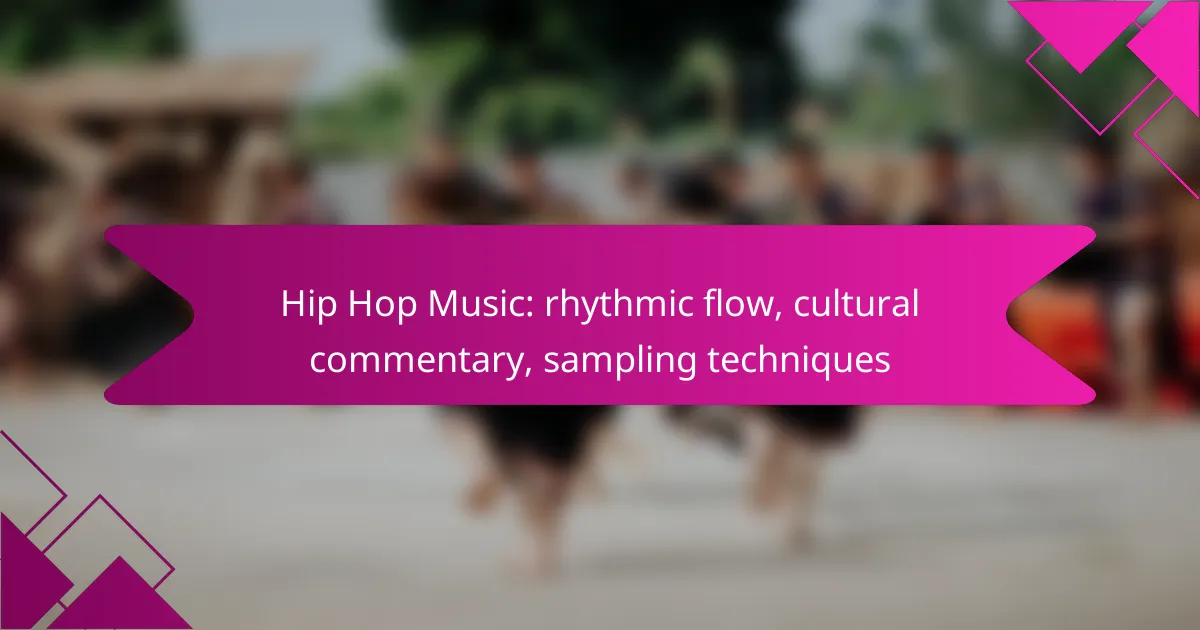Hip hop music is characterized by its rhythmic flow, which significantly influences the delivery and emotional resonance of the lyrics. Through innovative sampling techniques, artists create a unique soundscape that blends diverse musical influences, enriching the genre’s cultural commentary. This dynamic form of expression not only entertains but also addresses social issues and personal narratives, making it a powerful vehicle for reflection and change.
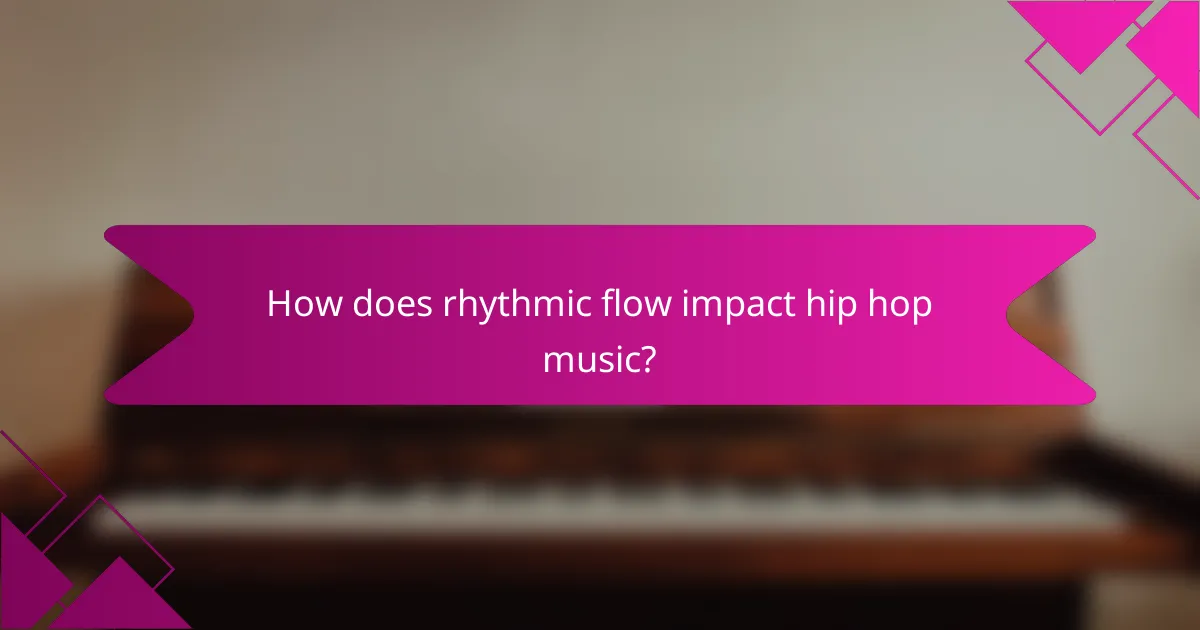
How does rhythmic flow impact hip hop music?
Rhythmic flow is crucial in hip hop music as it shapes the delivery and emotional impact of the lyrics. A well-crafted flow enhances the overall listening experience, making it more engaging and memorable.
Definition of rhythmic flow
Rhythmic flow refers to the pattern and pace at which a rapper delivers their lyrics over a beat. It encompasses elements such as timing, phrasing, and the interplay between words and music. A strong flow allows artists to create a unique signature style that resonates with listeners.
Examples of rhythmic flow in popular tracks
Tracks like Nas’s “N.Y. State of Mind” and Kendrick Lamar’s “HUMBLE.” showcase distinct rhythmic flows that contribute to their impact. Nas employs a complex, syncopated flow that complements the gritty beat, while Kendrick uses a more straightforward yet dynamic flow to emphasize key messages. These variations illustrate how different flows can enhance the storytelling aspect of hip hop.
Influence on listener engagement
The rhythmic flow significantly influences how listeners connect with a track. A captivating flow can draw listeners in, making them more likely to remember the song and its message. Conversely, a poorly executed flow may disengage the audience, leading to a lack of interest in the music.
To maximize listener engagement, artists should experiment with different flows and find a balance between complexity and accessibility. This approach can help maintain listener interest while delivering impactful lyrics effectively.

What are the key sampling techniques in hip hop?
Sampling techniques in hip hop involve taking snippets of existing recordings to create new music. This practice allows artists to blend various sounds and styles, contributing to the genre’s rich tapestry of rhythm and cultural commentary.
Types of sampling methods
There are several types of sampling methods used in hip hop, including loop sampling, one-shot sampling, and pitch shifting. Loop sampling involves repeating a short segment of music, while one-shot sampling captures a single sound or note for use in a track. Pitch shifting alters the frequency of a sample to fit the desired key or mood of the song.
Another common method is time-stretching, which changes the speed of a sample without affecting its pitch. Each technique offers unique creative possibilities, allowing producers to craft distinctive beats and soundscapes.
Notable hip hop songs that utilize sampling
Many iconic hip hop tracks prominently feature sampling. For example, “Juicy” by The Notorious B.I.G. samples “Juicy Fruit” by Mtume, creating a smooth backdrop for the lyrics. Similarly, “Stronger” by Kanye West incorporates a sample from Daft Punk’s “Harder, Better, Faster, Stronger,” blending electronic and hip hop elements seamlessly.
Other notable examples include “N.Y. State of Mind” by Nas, which samples “Mind Rain” by Billy Cobham, and “C.R.E.A.M.” by Wu-Tang Clan, which uses a sample from “As Long As I’ve Got You” by The Charmels. These tracks highlight the creative potential of sampling in shaping hip hop music.
Legal considerations for sampling
When sampling in hip hop, legal considerations are crucial to avoid copyright infringement. Artists must obtain permission from the original copyright holders, which often involves negotiating licensing fees. The cost can vary widely, depending on the popularity of the sampled work and the intended use.
Additionally, the “fair use” doctrine may apply in some cases, allowing limited use of samples without permission, but this is often a gray area and can lead to legal disputes. It’s advisable for artists to consult legal experts when planning to use samples to ensure compliance with copyright laws and to protect their work.
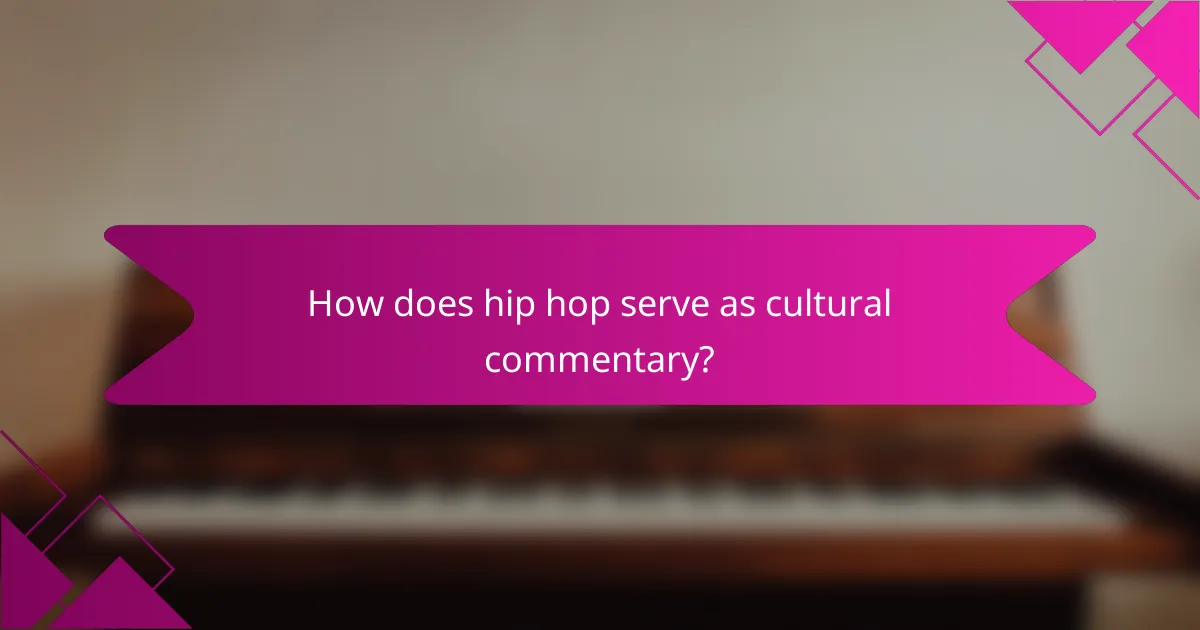
How does hip hop serve as cultural commentary?
Hip hop serves as cultural commentary by reflecting social issues, personal experiences, and political sentiments through its lyrics and rhythms. Artists use their platform to address injustices, celebrate cultural identity, and provoke thought among listeners.
Historical context of hip hop as commentary
Emerging in the 1970s in the Bronx, hip hop began as a voice for marginalized communities, addressing poverty, violence, and systemic racism. The genre quickly evolved, with artists using their music to narrate the struggles and triumphs of urban life. This historical backdrop laid the foundation for hip hop as a powerful medium for social critique.
Throughout the 1980s and 1990s, hip hop became increasingly political, with tracks that highlighted civil rights issues and called for social change. This period saw the rise of conscious rap, where artists like Public Enemy and KRS-One used their music to challenge societal norms and advocate for justice.
Influential artists known for cultural commentary
Several hip hop artists have made significant contributions to cultural commentary. Tupac Shakur is renowned for his poignant lyrics that addressed poverty, racism, and violence, making him a voice for the disenfranchised. His songs, such as “Changes” and “Keep Ya Head Up,” resonate with themes of resilience and social justice.
Other notable figures include Nas, whose album “Illmatic” is often cited for its vivid storytelling and social critique, and Kendrick Lamar, who explores themes of identity and systemic oppression in works like “To Pimp a Butterfly.” These artists exemplify how hip hop can articulate complex cultural narratives.
Impact on social movements
Hip hop has played a crucial role in various social movements, serving as an anthem for activism. The genre has been instrumental in movements such as Black Lives Matter, where artists use their influence to raise awareness about police brutality and racial inequality. Songs like “Alright” by Kendrick Lamar have become rallying cries for change.
Additionally, hip hop’s global reach has inspired activism beyond the United States, with artists around the world addressing local issues through their music. This interconnectedness highlights hip hop’s ability to unify diverse voices in the fight for social justice and equality.
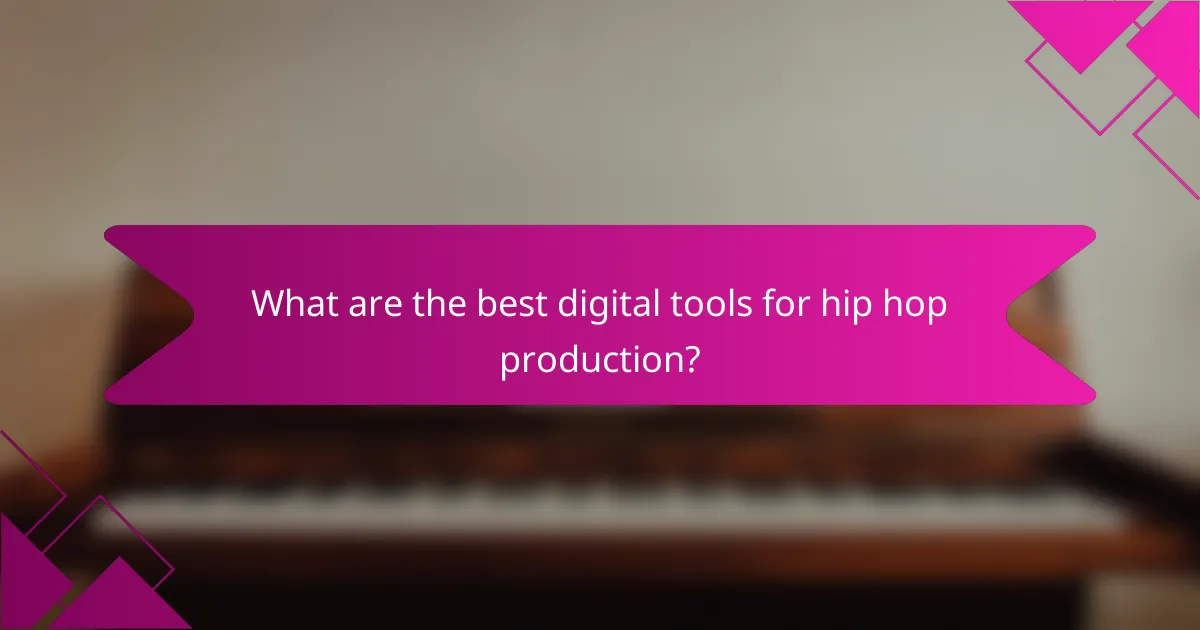
What are the best digital tools for hip hop production?
The best digital tools for hip hop production include digital audio workstations (DAWs), plugins for sampling and mixing, and various hardware options. These tools help producers create beats, manipulate sounds, and enhance the overall quality of their tracks.
Popular DAWs for hip hop music
Some of the most popular DAWs for hip hop production are Ableton Live, FL Studio, and Logic Pro X. Each of these platforms offers unique features that cater to beat-making, sampling, and live performance, making them favorites among hip hop producers.
When choosing a DAW, consider factors like workflow, ease of use, and compatibility with your hardware. For instance, FL Studio is known for its intuitive interface and strong MIDI capabilities, while Ableton Live excels in live performance settings.
Essential plugins for sampling and mixing
Key plugins for sampling and mixing in hip hop include Native Instruments’ Kontakt, iZotope Ozone, and Waves plugins. These tools provide powerful sound manipulation capabilities, allowing producers to create unique samples and achieve professional-sounding mixes.
When selecting plugins, look for those that offer versatile sound libraries and intuitive interfaces. For example, Kontakt is widely used for its extensive sample library, while Ozone is popular for its mastering features. Investing in a few high-quality plugins can significantly enhance your production quality.
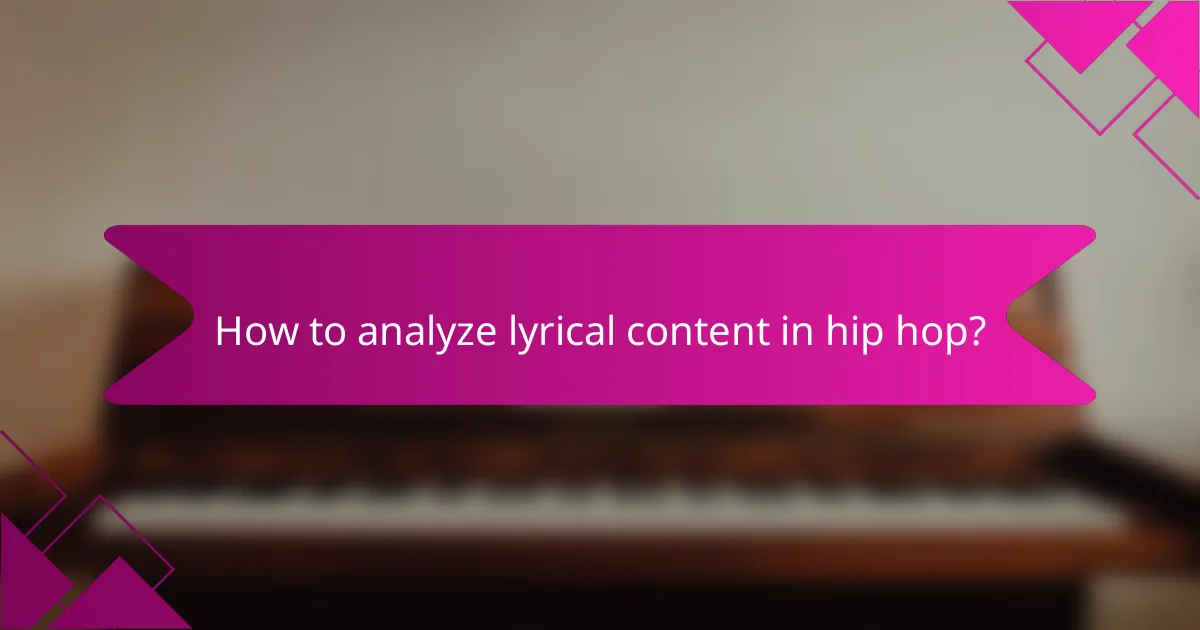
How to analyze lyrical content in hip hop?
To analyze lyrical content in hip hop, focus on the themes, wordplay, and cultural references within the lyrics. Consider the artist’s intent, the context of the lyrics, and how they reflect societal issues or personal experiences.
Techniques for lyrical analysis
Begin by identifying the central themes in the lyrics, such as social justice, personal struggle, or celebration. Look for literary devices like metaphors, similes, and alliteration that enhance the message. Pay attention to the rhythm and flow, as these elements contribute significantly to the overall impact of the lyrics.
Another effective technique is to compare the lyrics to the artist’s background and the historical context of the genre. Understanding the cultural significance of certain phrases or references can deepen your analysis. Additionally, consider how sampling techniques influence the lyrical content, as they often bring new meanings to the words through musical context.
Examples of impactful lyrics
One notable example is Kendrick Lamar’s “Alright,” which uses the phrase “We gon’ be alright” as a powerful anthem of resilience amidst adversity. This lyric resonates deeply within the context of social movements, making it a pivotal moment in contemporary hip hop.
Another example is Nas’s “The Message,” which highlights urban struggles and societal issues through vivid imagery and storytelling. The line “I never sleep, ’cause sleep is the cousin of death” encapsulates the urgency and harsh realities faced by many in marginalized communities. Such impactful lyrics often serve as cultural commentary, reflecting the artist’s environment and experiences.
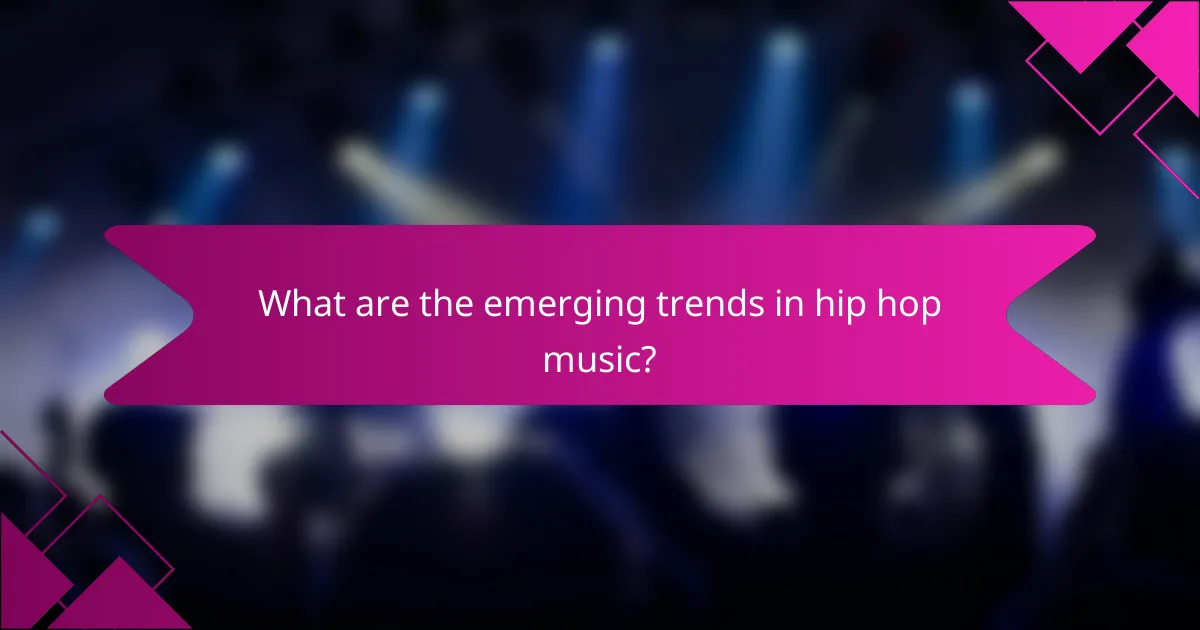
What are the emerging trends in hip hop music?
Emerging trends in hip hop music reflect a dynamic evolution influenced by technology, cultural shifts, and new subgenres. Artists are increasingly experimenting with sound, lyrical themes, and production techniques to resonate with diverse audiences.
Influence of technology on hip hop
Technology has significantly transformed hip hop music, particularly through digital production tools and social media platforms. Artists can now create high-quality tracks using affordable software, enabling a broader range of voices to enter the scene.
Moreover, platforms like TikTok and SoundCloud allow for rapid sharing and discovery of new music, often leading to viral hits. This democratization of music production means that emerging artists can gain recognition without traditional record label support.
New subgenres gaining popularity
Several new subgenres are gaining traction within hip hop, reflecting diverse influences and cultural backgrounds. For instance, trap music continues to dominate with its heavy bass and rhythmic beats, while lo-fi hip hop is popular for its mellow, chill vibes often used for studying or relaxation.
Additionally, genres like drill, characterized by its aggressive beats and lyrical content, are becoming more mainstream, particularly in urban areas. These subgenres not only showcase different musical styles but also highlight the cultural narratives and experiences of their creators.
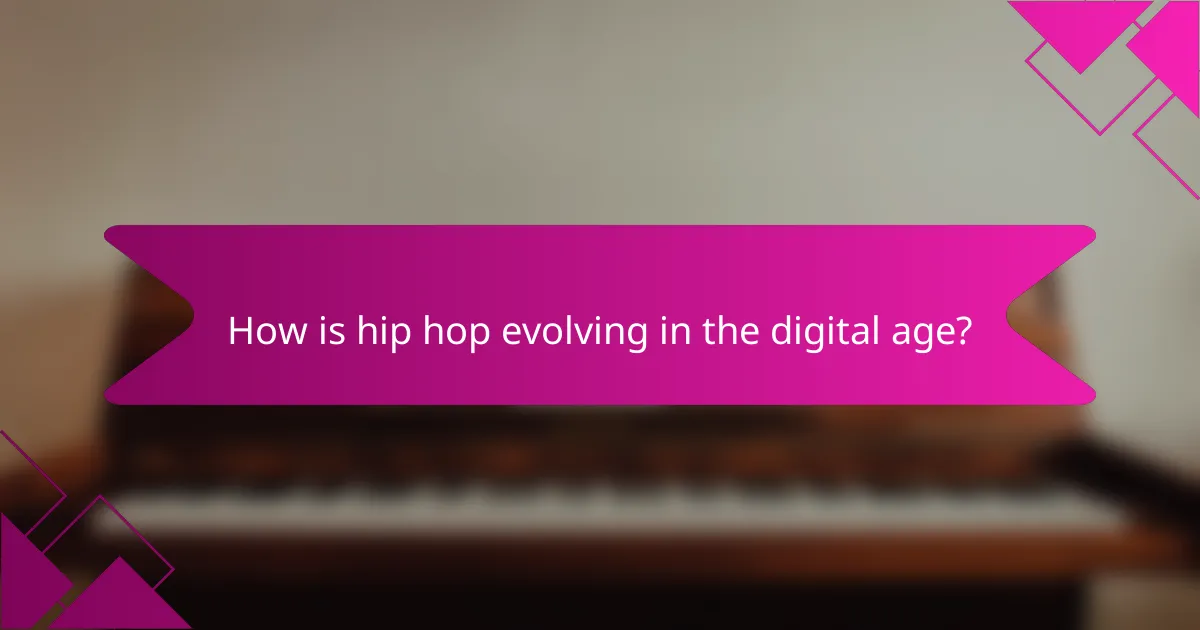
How is hip hop evolving in the digital age?
Hip hop is evolving rapidly in the digital age, driven by advancements in technology and shifts in consumer behavior. Artists are leveraging digital platforms to reach wider audiences, experiment with new sounds, and engage with fans in innovative ways.
Impact of streaming on hip hop artists
Streaming has transformed how hip hop artists distribute their music and generate revenue. Platforms like Spotify and Apple Music allow artists to reach millions of listeners without the need for traditional record labels, which can lead to greater creative freedom.
However, the financial model of streaming often means that artists earn significantly less per stream compared to physical sales or downloads. Many artists now focus on building a loyal fanbase through live performances and merchandise to supplement their income.
Role of social media in music promotion
Social media plays a crucial role in promoting hip hop music, allowing artists to connect directly with fans and share their work instantly. Platforms like Instagram, TikTok, and Twitter enable artists to showcase their personalities and engage in real-time conversations with their audience.
Effective use of social media can lead to viral moments that significantly boost an artist’s visibility. However, artists should be mindful of maintaining authenticity and not overexposing themselves, as this can dilute their brand and impact. Regularly posting engaging content while balancing personal and professional life is key to successful promotion.
